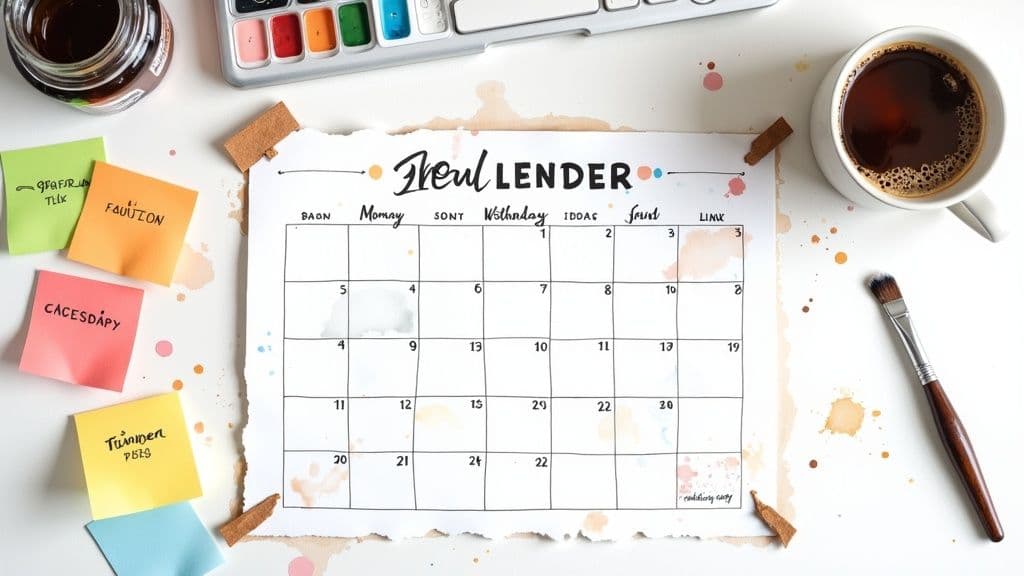
How to Create Mockups That Impress Your Clients
Learn how to create mockups that win projects. This guide covers planning, tool selection, and presentation tips for designers.
Download our free social media content calendar template to streamline your content planning, organize posts, and boost engagement across all your channels.

Instastock Team
October 28, 2025 • 13 min read
Think of a social media content calendar template as your command centre. It’s essentially a pre-made layout—usually a spreadsheet or a board in a project management tool—that lets you map out and schedule all your social media posts ahead of time. It's the difference between chaotic, last-minute posting and running a smooth, strategic operation that actually builds your brand.

Do you ever get that "Oh no, I haven't posted today!" feeling? You're definitely not alone. So many businesses get stuck in a reactive loop, just grabbing whatever they can think of and throwing it online. Not only is that incredibly stressful, but it also results in a disjointed brand voice and a lot of missed chances to connect with your audience.
This is where a content calendar becomes your most valuable asset. It’s so much more than a simple spreadsheet.
Instead of just reacting to the day-to-day, a calendar lets you step back and see the bigger picture. You start building a proper narrative, transforming random posts into a focused strategy where every single piece of content is pulling its weight and moving you closer to your business goals. The benefits of digital marketing truly shine when your efforts are consistent and well-planned, and a calendar is the key to unlocking that.
A solid calendar becomes your team's single source of truth. Whether you're a one-person show or part of a larger team, everyone can see what's coming up, what's being worked on, and what's already gone live. This simple alignment puts a stop to duplicated work and ensures everyone is speaking with the same voice, creating a unified brand message everywhere you post.
Imagine a UK-based retailer planning for major shopping events. With a calendar, they can map out their Black Friday and Bank Holiday sales campaigns weeks, or even months, in advance. That means all the graphics are designed, the copy is polished, and everything is approved long before the last-minute panic sets in.
A content calendar doesn't just organise your posts; it organises your thinking. It forces you to be intentional about your messaging, timing, and goals, turning social media from a daily chore into a powerful growth engine.
Planning ahead also means you can be much more strategic with your timing. You can tap into cultural moments that really resonate with your audience. Think about mapping out national holidays, key industry events, or even just fun hashtag days like #NationalTeaDay. This lets you create timely content that feels fresh, relevant, and naturally boosts engagement.
The online world is only getting more crowded. By 2025, it's estimated that 79% of the UK population—that's roughly 54.8 million people—will be active on social media. On top of that, social ad spending in the UK is projected to reach an eye-watering £9.95 billion in the same year.
With that level of competition, a planned, consistent approach isn't just a nice-to-have anymore. It's absolutely essential if you want to cut through the noise.
In the end, it boils down to a few core advantages:

Alright, let's get into the good stuff – building a calendar that actually works for you. Creating your own social media content calendar template isn't about ticking boxes; it's about crafting a central hub for your content that moves you from last-minute panic to purposeful planning.
Your very first decision is what tool to build it in. Honestly, there's no single "best" option here. It really comes down to your team's size, your budget, and how you like to work.
Think about it this way: a small independent coffee shop in the UK would probably find a simple Google Sheet to be the perfect, no-cost solution. But a larger marketing agency managing multiple client calendars? They'd get so much more value from the collaborative power of a tool like Asana.
Once you've picked your home base, it's time to lay the foundations. A truly great content calendar is all about having the right information organised in the right way. If you want some inspiration before you start, checking out a guide that makes the social media calendar template made simple can give you some brilliant ideas.
To turn a blank page into a powerful planning tool, you need to add the right columns. These are what I consider the absolute essentials for any social media calendar, whether it's a simple spreadsheet or a complex project management board.
Here’s a breakdown of the crucial columns every effective social media content calendar should include to stay organised.
| Component | What It Is | Why It's Important |
|---|---|---|
| Date & Time | The exact day and time your post is scheduled to go live. | Helps you visualise your posting cadence and ensures consistency. |
| Platform | Which social channel the post is for (e.g., Instagram, TikTok, LinkedIn). | Crucial for tailoring content and tone to the right audience. |
| Content Format | Is it a Reel, Carousel, single image, Story, or text post? | Guarantees you're creating a varied and engaging mix of content. |
| Caption/Copy | The complete text for the post, including any calls-to-action. | Having it here makes review, editing, and scheduling a breeze. |
| Visuals | A link to the final asset (e.g., in a Dropbox or Google Drive folder). | Keeps everyone on the same page and avoids last-minute file hunting. |
| Hashtags | A list of the specific hashtags planned for that post. | Ensures your hashtag strategy is intentional and not an afterthought. |
| Status | A dropdown menu to track progress (e.g., Idea, In Progress, Awaiting Approval, Scheduled). | Gives you a bird's-eye view of your entire content pipeline. |
Getting these basics locked in is the most important step. It creates a system that anyone on your team can understand and follow.
Let’s go back to our UK coffee shop, "The Daily Grind," and see how they might use their new spreadsheet calendar.
A quick look at their plan for the week might look something like this:
| Date | Platform | Format | Caption | Visuals | Status |
|---|---|---|---|---|---|
| 11 Nov | Reel | "Watch our head barista create the perfect flat white! What's your go-to coffee order? ☕ #CoffeeArt" | Link to video file | Scheduled | |
| 12 Nov | Photo | "Meet Sarah, our baker! She's the genius behind our famous cinnamon swirls. Say hello! 👋" | Link to photo | Approved | |
| 13 Nov | Carousel | "Three ways to enjoy our new seasonal blend. Swipe to see them all! ➡️ #AutumnBlend" | Link to graphics | In Progress |
See? This simple layout gives them a clear overview, helps them maintain a healthy mix of content (promotional, educational, and community-building), and keeps the whole team aligned.
As your strategy gets more sophisticated, you can easily add more columns, like "Paid Ad Budget" or "Performance Metrics," to track results. Of course, dreaming up all this content takes time, which is why exploring AI for content creation can be a real game-changer for speeding up your workflow.

Creating brilliant content is one thing, but getting it in front of the right people? That’s where the real work begins. One of the biggest mistakes I see is businesses trying to be everywhere at once. It’s a recipe for burnout, spreading your team thin and watering down your message.
Your social media content calendar template should be a tool for focus, not a checklist for every platform under the sun. It’s about being smart and strategic, homing in on where your UK audience genuinely hangs out online.
Every platform has its own vibe and unwritten rules. Think about it – you wouldn't wear a three-piece suit to a casual pub quiz, would you? In the same way, a dry corporate announcement is going to fall completely flat on TikTok. The trick is to match your brand’s personality and content style to the platform's natural environment.
A B2B tech firm based in Manchester, for example, would be wise to pour its efforts into LinkedIn, sharing industry insights and detailed case studies to connect with other professionals. Contrast that with a new fashion startup in London, which would thrive on the visual-first feeds of Instagram and the fast-paced, trend-driven world of TikTok.
To really nail your calendar, you have to get to grips with the nuances of each platform. The UK social media scene is massive, with millions of us scrolling every day, but each channel has its own demographic sweet spot.
Here’s a quick rundown to get you thinking:
The best social media strategies are laser-focused. It's far better to be brilliant on one or two key channels than to be just 'okay' on five. Your calendar should reflect this, enabling you to create deeper, more engaging content for the right people.
With around 54.8 million social media user identities in the UK, you can't afford to just guess. People are spread across major players like YouTube, Facebook, and Instagram, with LinkedIn alone having roughly 45 million user profiles. A properly structured content calendar is what helps you tailor your message for each one, from TikTok’s Gen Z audience to LinkedIn’s B2B professionals. If you want to dig deeper, you can find more insights about UK social media usage to help guide your strategy.
Ultimately, your own data is your most powerful tool. Dive into your analytics and see what’s already working. Where is your engagement strongest? Don't be afraid to test the waters on a new platform, but always let the results dictate where you invest your time and creativity. This focused approach is how you turn a content calendar from a simple spreadsheet into something that drives real results.

So, you've got your template. Right now, it’s just a grid of empty boxes, but this is where the fun begins. The real magic is in filling those boxes with ideas that genuinely resonate with your audience, turning that blank slate into a powerful communication tool.
Instead of scrambling for last-minute ideas (we’ve all been there), a bit of forward planning ensures your feed is consistently interesting, always on-brand, and actually works towards your goals.
The secret? Core content pillars.
Think of these as the handful of major themes your brand will own. They’re the topics you’ll return to, time and time again. For a UK-based artisan bakery, for instance, these pillars could be "Behind the Bake," "Local Supplier Spotlights," and "Sourdough Tips." Having these defined makes brainstorming a hundred times easier because you always have a solid foundation to build upon.
Your content pillars are the backbone of your social media strategy. They give you structure and make sure every post, story, and video reinforces what your brand is all about, building a strong, recognisable identity over time.
With your pillars set, brainstorming becomes a much more focused and creative process. You're not just trying to fill space in your social media content calendar template; you're building a vibrant mix of content that gives people a reason to follow you and stick around.
Here are a few tried-and-tested ways to unearth those golden nuggets of content:
Remember, a dynamic feed is a varied one. Don't fall into the trap of posting the same type of content every single day. Weaving in a mix of formats—from single images and carousels to Reels and Stories—is crucial for keeping things fresh. If you want to dive deeper, learning how to improve social media engagement is a great next step, as it often comes down to experimenting with different formats to see what clicks.
A brilliant way to make your content feel incredibly relevant and timely is to sync it with the UK's unique calendar of events and holidays. This goes way beyond just a token post for Christmas or Easter.
Think about planning content around:
By simply adding a "Key UK Dates" layer to your calendar, you can plan campaigns that feel genuinely connected to what people in the UK are talking about, making your brand part of the national conversation.
You can create the most incredible, jaw-dropping content, but if you post it when no one’s around, it's like performing to an empty theatre. You’ve poured your heart and soul into it, but the audience just isn't there. That's why the 'when' in your social media content calendar template is every bit as crucial as the 'what'.
Pinpointing the perfect time to post for a UK audience isn’t about finding one magical hour that works for every brand. It’s about getting to know your specific audience and their daily digital habits.
Your own platform analytics are your secret weapon here. Dive deep into your Instagram Insights or Facebook Business Suite and have a proper look at when your followers are most active. This data is pure gold; it shows you the exact moments your community is scrolling, liking, and commenting.
While your own data will always be the most accurate guide, there are some well-established patterns that give you a brilliant starting point. To really get a feel for when to publish your content for maximum reach in the UK, you can explore a more detailed analysis of the best times to post on social media in 2025 to get a deeper understanding.
For a UK audience, you’ll typically find the sweet spots are during these key moments of the day:
Don’t just set it and forget it. Treat these general times as your starting hypothesis, then test them like a scientist. Post at 8 AM one week and 1 PM the next. Let your analytics be the judge of which slot performed better.
Getting this right is becoming more and more important. The average daily time spent on social media in the UK is projected to be just 1 hour and 37 minutes in 2025, which is a drop of 11% from 2023. With less time to grab someone's attention, scheduling your content to land during peak activity is vital. You can read the full Sprout Social research for more details on these trends.
Ultimately, your calendar needs a dedicated column for your posting times. Fill it in based on your research, keep a close eye on the performance of each slot, and refine your schedule every single month. This simple step transforms your calendar from a basic planner into a powerful tool for boosting your visibility.
Diving into a new workflow always throws up a few questions. Building a social media content calendar is a brilliant move, but it's totally normal to have some queries about the day-to-day practicalities. Let's run through a few of the most common ones I hear.
This is the big one. How far is too far, and what's not far enough?
While there's no magic number, a solid rule of thumb is to plan your core content one month in advance. This gives you enough breathing room to be thoughtful, produce quality creative without the last-minute panic, and get sign-off from anyone who needs to see it.
The key, though, is to leave a little wiggle room. Don't schedule every single slot.
Life happens. A bit of breaking news drops, a new meme takes over the internet, or an unexpected company announcement lands in your lap. This is where a flexible calendar proves its worth.
A great content calendar isn't set in stone; think of it as a living, breathing guide. Here’s how you can handle last-minute posts without throwing your entire strategy into chaos:
The trick is to see your calendar not as a rigid rulebook, but as a framework that helps you be both organised and opportunistic.
Your social media calendar template gives you the structure for consistency. Its real magic, however, is the agility it offers to pivot when an opportunity—or a crisis—appears. It's about planned spontaneity.
With so many options, from a simple spreadsheet to a pricey, all-singing, all-dancing platform, how do you pick the right one? Honestly, the best tool is the one your team will actually use every day.
Think about these points when you're deciding:
My advice is always to start simple. You can move to a more complex system later as your team and your social media strategy grow. The immediate goal is to get organised, not to get bogged down learning a new piece of software.
Ready to stop guessing and start creating? Instastock is your AI-powered partner for generating unique, on-brand visuals in seconds. Say goodbye to licensing fees and creative blocks. Try it for free and create your first five images today at https://instastock.studio.

Learn how to create mockups that win projects. This guide covers planning, tool selection, and presentation tips for designers.

What is omnichannel marketing? Learn how to build a seamless customer experience that drives loyalty and growth for your UK business with this practical guide.

Your complete guide to social media image dimensions. Get the latest sizes and best practices for Instagram, Facebook, X, and LinkedIn to optimize your content.